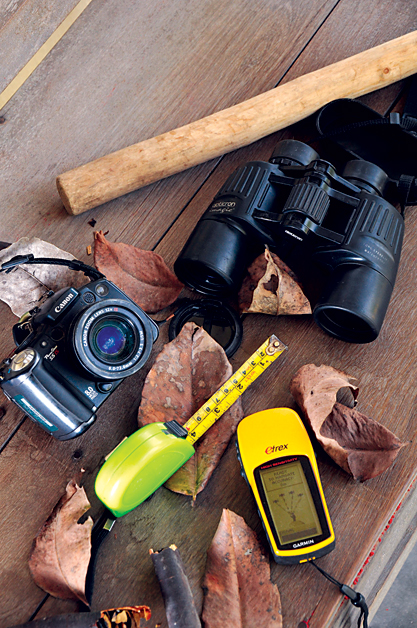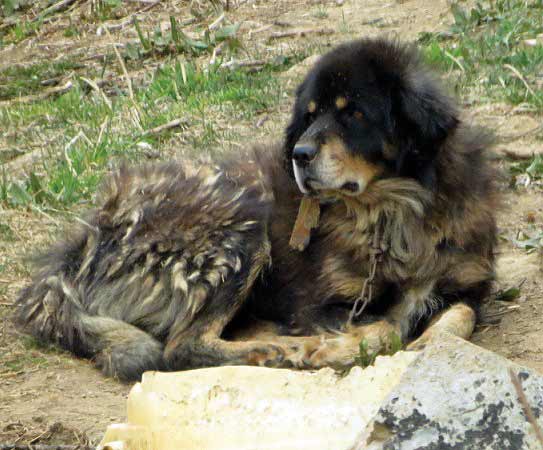The question is not, Can they reason? Nor, Can they talk? But, Can they suffer? Jeremy Benthem 1748-1832: Principles of Morals and Legislation (1789)
Tow can I make you understand just how hot it was, to feel the incessant perspiration cascading down my back, sticking my shirt to my body? The feeling of the sun baking my face, as I ride along flatland village roads. It was hotter than anything I had ever felt before and, hopefully will never feel again.
The sun was at it’s noon-time high, the grass surrounding the compound of the Warden’s office was losing its green sheen from the pre-monsoon rains, turning rust brown. The full onslaught of the rainy season would be soon upon them. I was sweating profusely. A short man in his late 30s arrives wearing earth colored pants, a dark beige top and green baseball cap; telling us the team is ready to move out; they’re brandishing long sticks. With dripping palms we pick up our kits and start to enter the deep bush that is Bardia National Park (BNP), on patrol with the Rangers.
As we move deeper into the jungle on foot, with the five-man team, the intermittent shade of colossal, old hardwoods offer little respite from the inferno. We didn’t expect much wildlife spotting at high noon, but maybe the team would stumble upon something else requiring their attention. Slowly and cautiously we proceed, eyes and senses alert for animals, and the dangers that patrolling on foot in the jungle can bring. The team is ever ready for tackling poachers who sneak into the park for a host of reasons. Rhino horns fetch big money, as do tigers and their different parts. Add to that the pilfering of hardwood trees, cutting of grass for home use by locals, stealing crocodile eggs, and the hunting of deer.
After some time of traveling through forest we arrive alongside a large river, now quite shallow, soon to fill; a marsh muggar crocodile with its long snout and jaw—perfect for catching fish, basks on the far bank. We follow the path back into the jungle. I walk at the lead with Mr. Indra Prasad, a sturdy looking fellow with a tidy moustache, who has been a BNP Ranger for twenty two years. The team begins to separate a little. We hear voices in the bush; Indra stops. Another team member catches up; he heads forward, alone, into the bush. The two rangers bringing up the rear have already entered the bush from another side—towards the voices. Indra and I wait; he looks poised. We hear a scurry, the sound of flight; at least two people are running away, deeper into the bush. And just like that, it’s over. I now understand a little of what it is that the Rangers do. Anybody who is legitimately in BNP, has done so by permit—500 rupees for foreigners and 30 rupees for Nepalis - meaning people who are legally there have no reason to run. Maybe they were laying traps, or having a break between cutting grasses or perhaps waiting near the river to shoot an animal coming later to the water for a drink. We’ll never know what their intention was. But hopefully for that day the park Rangers averted another fatal poaching of a precious animal.
BNP’S History and it’s Rangers
The park started its life in 1969 as a hunting reserve for Nepal’s Royal Family, where they would come to shoot big game when visiting the west. But Bardia didn’t see them as much as did Chitwan. Back then rhino, elephant and tiger along with deer were plentiful and the royals, a few. Then in 1982 Bardia was re-named The Royal Bardia Wildlife Reserve until 1988, when it became a National Park. 1986 saw the reintroduction of rhino from Chitwan to the near-depleted population in Bardia, and soon after the Rangers came to be in the park for protecting and monitoring the rhino.
 Then with the recent years of fighting and instability, Bardia became a tense place. For safety, the Rangers’ patrols were scaled back. This became what one Assistant Warden called “a golden time for poaching”. Before the conflict there were 83 Great One Horned Rhino of breeding age. Today there are only 22. Tigers didn’t fare much better, from a healthy 186 down to a mere 18 of breeding age today. The number of wild elephant poached were not so bad due to a corridor connecting BNP with Kasta Ghat, a protected zone on the Indian side of the border, and also because compared to their African cousins the tusk of the Asian elephant is smaller and fetch much less at the market.
Then with the recent years of fighting and instability, Bardia became a tense place. For safety, the Rangers’ patrols were scaled back. This became what one Assistant Warden called “a golden time for poaching”. Before the conflict there were 83 Great One Horned Rhino of breeding age. Today there are only 22. Tigers didn’t fare much better, from a healthy 186 down to a mere 18 of breeding age today. The number of wild elephant poached were not so bad due to a corridor connecting BNP with Kasta Ghat, a protected zone on the Indian side of the border, and also because compared to their African cousins the tusk of the Asian elephant is smaller and fetch much less at the market.
With the conflict now over, the Park’s Warden, five Assistants, and seven Rangers, along with Monitors from the National Trust, and the Army’s Special Protection Unit are all working hard to combat poachers, protect the remaining wild life and provide space for animal numbers to rebuild. They work with a myriad of tools such as regular foot/boat/elephant/jeep/bicycle patrols across the 968 sq. kms of jungle. Other projects and programs include: animal identification programs (e.g. a scar), tagging, photographing animals on trails with triggered cameras, GPS units for recording sightings—finding patterns in animal behavior and their poaching. Community programs and initiatives are also at the top of the list, such as a 327 sq. km Buffer Zone (BZ) where the community can both live and get resources for their daily lives, schooling, scholarships, cash cropping projects such as mint and it’s oil (which has brought a noticeable change to locals’ livelihoods). In turn, the protection of wildlife helps generate a growing tourism economy.
Poaching - Who How Where Why and When
 I sit in an old office, with filing cabinets lined on the back wall. Two desks are in front of me, we sit to the left. Across from me is Mr. Ashok Bhandari, one of five Assistant Wardens of BNP. Looking to be in his 40s, he sports a moustache and tidy haircut, and appears to be taking the mid-day heat in his stride. Not a drop of perspiration adorns him. I on the other hand am not so composed.
I sit in an old office, with filing cabinets lined on the back wall. Two desks are in front of me, we sit to the left. Across from me is Mr. Ashok Bhandari, one of five Assistant Wardens of BNP. Looking to be in his 40s, he sports a moustache and tidy haircut, and appears to be taking the mid-day heat in his stride. Not a drop of perspiration adorns him. I on the other hand am not so composed.
He fills me in with all the loose information I need about the park and then I move to ask him my strongest question… How does the world of poaching work, where does it go, what’s it worth and who’s doing it. Bhandari’s face takes on a grim look. He starts by saying “as far as we understand it”. As far as it is understood, it is smugglers who hire local poachers to shoot animals and of course a poacher can also take items to a smuggler he knows. It seems the largest percentage of animal parts are smuggled north, to Tibet and into China’s markets. Not just BNP’s, but the entire sub-continent’s poached animals move this way.
We examine the example of the rhino—mostly only the horn is taken. For this a poacher earns a huge amount of money, depending on the size of the horn and of course the market. And what is it used for? When powdered the horn is mostly used as a male aphrodisiac.
A tiger’s two front teeth can earn around one lakh a piece and then you have the skin, which is highly prized along with its bones, meat and penis. The number of rhinos in BNP before the war was 83 and today stands at 22—that means at least 61 rhinos have been lost. From only rhino horns the poaching market in the region has earned to the tune of Rs. 1,220 lakh (averaging Rs. 20 lakh per horn).
Then the warden goes on to explain how the poaching of BNP’s hardwoods like Sal trees is also another major problem. We then prepare to go on patrol with the Rangers.
Later that evening after the patrol, I speak with some of the locals. Sitting in a circle in a dark open field, illuminated by rechargeable lanterns, we talk about why poaching happens. They give me the traditional reasoning behind it - not the big markets and big money. We start with crocodile eggs. Locals believe that they possess great power for the body. BNP has now established a Crocodile Breeding Centre, where eggs are taken to hatch in a safe environment, and released later. When visiting the centre I had seen over two dozen muggar and gharial crocodiles being raised.
We move on again to talking about rhinos. I am informed about strange old practices - such as water passed through rhino skin is believed to travel to ancestors who have passed away to the other world; dried rhino blood is used to regulate menstruation problems in women; the skin of a rhino, if wrapped around a stick, while beating someone, will leave no visible marks of the assault. These are but a few of the strange beliefs that locals had before and a small number still do.
Tigers have always been in demand. The powdered bones of the king of beasts is believed to bring great power, a tooth on a necklace protection, the dried penis virility in men, it’s blood and organs also possessing different powers if ingested.
The Rangers
The Rangers themselves are a collection of people from over Nepal. In BNP most of the Rangers that I met came from the local Tharu community. The Warden and Assistant Wardens come from outside Bardia. Most have worked in at least one other park. Assistant Warden Bhandari for example, came to BNP via Khaptad National Park in the western Himalayan region. Many Rangers in BNP have more than a decade of experience. Mr Bhandari tells me that the Rangers and staff of the park work 24/7; they are always on duty, albeit not in the strict sense. They work in some of the remotest and inhospitable parts of the country, protecting some of the nations most precious and sensitive wildlife resourses. And it’s not just rhinos and tigers; on the list are elephants, deer, blue sheep, water buffalo, Gangetic dolphins, red pandas, bears, leopards, crocodiles, butterflies, and birds.
The Rangers and Wardens work for the Department of Forestry. These days to be a Ranger one must complete at least a year of courses/trainings at the Institute of Forestry in Pokhara and Hetauda. It is definitely not an easy life, but nonetheless a necessary one. I think about the men and women in the jungles and hills of Nepal as I cross the steaming runway in Nepalgunj. 42 degrees! And I praise them.
Pat Kauba is a freelance writer and photographer who can be contacted at patkauba@gmail. com. Kapil Bisht is an avid wildlife enthusiast and writer. He can be contacted at papercloudtree@ hotmail.com.










